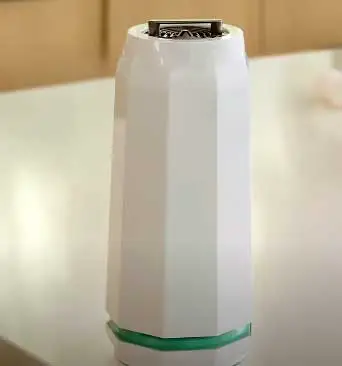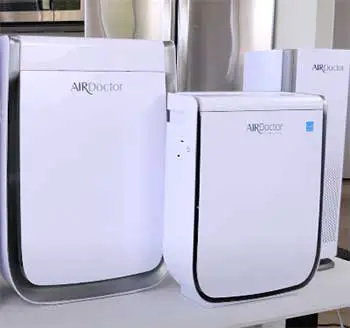Indoor air can contain various pollutants that can negatively impact health and comfort. From pet dander and dust to volatile organic compounds (VOCs) from household cleaners and building materials, poor indoor air quality is an issue many homeowners face.
That’s why investing in an effective air purifying system is important.
Two popular options are the Puraclenz and AirDoctor air purifiers, but how do they compare? We break things down in the chart below:
| Feature | Puraclenz | AirDoctor |
| Technology | Uses activated carbon filter along with HEPA filter to remove airborne particles, allergens etc | Uses medical grade H13 HEPA filter, UV-C light and activated carbon filter to remove airborne particles, allergens etc |
| Room Coverage | Covers 1300 sq ft | Covers 1100 sq ft |
| Noise Level | Ultra quiet at 22 – 48 dB | Fairly quiet at 32 – 60 dB |
| Price | $499 | $849 |
| Warranty | 2 years | 5 years |
| Smart Features | Can connect to app to monitor usage | Can connect to app with air quality monitoring and auto adjustments |
Both units effectively clean the air using multiple filtration stages, but there are some key differences in terms of technology, smart features, noise level and more. Keep reading as we explore each air purifier in-depth.
Overview of the Puraclenz Air Purifier
The Puraclenz air purifier features a contemporary design with easy-to-use touch controls. It combines a true HEPA filter, activated carbon filter and ion generator to remove airborne particles, allergens, odors and more down to 0.1 microns.
Some advantages of the Puraclenz include:

- Covers up to 1300 square feet, making it suitable for large rooms and open floor plans
- Ultra quiet operation ranging from 22 – 48 decibels for uninterrupted sleep and concentration
- Effectively reduces dust, pet dander, pollen, smoke, VOCs and other household odors
- Long 2 year warranty provides peace of mind on parts and performance
While effective at cleaning the air, the Puraclenz lacks some smart functionality that newer models provide.
It cannot automatically adjust settings based on air quality readings or be controlled remotely via smartphone app.
It also does not use UV-C light for destroying biological pollutants.
Overview of the AirDoctor Air Purifier
As a medical-grade model designed specifically for allergy and asthma sufferers, the AirDoctor air purifier packs some top-tier features. It combines a hospital-grade H13 HEPA filter, activated carbon filter, UV-C light and ionizer using multiple fan speeds to deeply clean indoor air.
Benefits of the AirDoctor include:

- Uses medical-grade filtration to capture particles as small as 0.1 microns
- UV-C light destroys biological pollutants like bacteria and viruses
- Covers rooms up to 1,100 square feet for whole home use
- Can automatically adjust settings based on air quality readings
- 5 year warranty provides support for parts and performance
While the AirDoctor performs exceptionally well, it comes at a premium price point.
It also operates at a slightly higher noise level between 32 to 60 decibels. The medical focus may also provide some overkill for those not suffering from severe allergies or respiratory issues.
Filtration Technology Comparison
One of the biggest differences between the two air purifiers is the filtration technology used.
The Puraclenz uses a 4-stage filtration system:
- Prefilter: Captures large particles like hair and dust
- True HEPA Filter: Removes 99.97% of particles 0.3 microns, including pollen, pet dander and smoke
- Activated Carbon Filter: Eliminates VOCs and household odors
- Ion Generator: Charges particles to enhance filtration
Meanwhile, the AirDoctor uses a 6-stage filtration system:
- Prefilter: Traps large particles like hair and dust
- H13 Medical-Grade HEPA: Removes 99.95% of particles 0.1 microns including mold, bacteria viruses
- Activated Carbon Filter: Reduces VOCs, odors and chemicals
- UV-C Light: Destroys biological contaminants
- Anion Generator: Produces negative ions to charge particles for enhanced filtration
- Optional Ionizer: Further charges particles to assist with removal
While both effectively remove particulate matter and allergens, the medical-grade H13 HEPA filter and UV-C light give the AirDoctor an edge in terms of FILTERING capabilities for medical conditions like allergies or asthma. The ionization stages also provide extra protection.
Room Coverage
When it comes to coverage, the Puraclenz holds a slight advantage:
- Puraclenz: 1,300 square feet
- AirDoctor: 1,100 square feet
The Puraclenz can handle larger rooms, making it a better choice for large open concept floors plans. But both units provide sufficient area coverage for spaces like studios, apartments and normal sized bedrooms.
Those with bigger homes may need to supplement with multiple units. Many factors impact results like ceiling height and layouts. But for general use, the differences in coverage should not make a major difference.
Noise Levels
Operating volume is another key consideration when shopping for any air purifier. Excessive fan noise can disrupt sleep, conversations and concentration during daily activities.
- Puraclenz: Ranges from 22 – 48 decibels on various fan speeds
- AirDoctor: Ranges from 32 – 60 decibels on various fan speeds
At the low end, the Puraclenz operates at 22 dBA which produces very little perceptible sound. Even at higher speeds, it remains quieter than the AirDoctor. But both units should work fine for bedroom usage in most cases since they avoid excessive noise even when ramped up.
Smart Features and Convenience
In terms of convenience, the AirDoctor pulls ahead thanks to its smart connectivity and automation:

- The AirDoctor connects to an app to provide real-time monitoring of air quality metrics like particulate levels. It auto-adjusts fan speeds based on readings to save energy and filtration costs when possible.
- The app also provides filter change reminders and general usage statistics to optimize performance.
- Meanwhile, the Puraclenz lacks app connectivity or any smart adjustments. It relies solely on manual speed adjustments.
For those wanting automation and ambient air quality info, the AirDoctor delivers better convenience and optimization.
But the Puraclenz still includes user-friendly mechanical controls for straightforward operation.
Cost Comparison
When it comes down to price, the Puraclenz clearly wins in terms of upfront affordability:
- Puraclenz: $499
- AirDoctor: $849
The nearly double price makes the AirDoctor a significant investment. For those wanting top-tier medical filtration without advanced features, the Puraclenz provides an attractive value.
However, keep operating costs in mind. The higher grade HEPA filter and UV bulb may need more frequent replacement on the AirDoctor. And the 5 year warranty does provide peace of mind for parts failures or issues.
Frequently Asked Questions (FAQ)
Yes, the Puraclenz air purifier effectively cleans indoor air by combining HEPA filtration with activated carbon and ionization to capture the majority of pollutants including allergens like dust and pollen. While not medical-grade, it removes VOCs, odors and particulate down to 0.1 microns for simpler air purification needs. Customers report major differences in indoor air quality, showing it adequately cleans air for common usage scenarios.
The “best” air purifier ultimately depends on individual household needs, room sizes, filtration capabilities required and budgets. Top brands rated highly for air cleaning performance include company names like Blueair, Austin Air, IQAir and Winix. But many lesser known companies offer quality air purification as well. Focus first on finding the right balance of key specifications for your situation before getting caught up on specific brand names. Medical-grade models specifically certified for allergy and asthma relief also comprise some of the best performing options in removing the widest range of indoor pollutants when needed.
Yes, Clarifion air purifiers use proven HEPA filtration technology along with UV-C light and activated carbon to effectively remove airborne particles, allergens, odors and more. While not as advanced as some higher-end medical air purifiers, Clarifion models have been independently tested to verify their performance claims. Customers generally report cleaner indoor air quality and allergy/asthma symptom relief after installing Clarifion units. So while moderately priced as more of a consumer model, Clarifion air purifiers do provide noticeable air cleaning capabilities for most home needs.
Many doctors specializing in allergies, asthma and respiratory health tend to recommend medical-grade air purifiers that meet strict standards for removing indoor triggers. Some brands frequently suggested include IQAir, Blueair, Austin Air along with personalized equipment like home oxygen concentrators for severe cases. Key features doctors advise looking for include true HEPA filtration down to at least 0.3 microns, activated carbon for chemicals/odors and supplemental UVC germicidal irradiation. Having remote monitoring, automatic adjustments and replacing filters on schedule also promotes ideal performance. Ultimately medical providers assess each patient’s specific sensitivities before suggesting the best air cleaning solution.
Closing Remarks
While both air purifiers effectively clean indoor air, the AirDoctor pulls ahead for those needing medical-level filtration. Extra stages like UV-C disinfection better remediate allergens, mold and illness-causing pathogens. Automatic adjustments and ambient tracking also optimize function.
But for general air cleaning, the Puraclenz still eliminates odors, VOCs and the majority of particulate with quiet, affordable performance. At the end of the day, consider your specific needs, filtration requirements and budget to make the best decision on improving your indoor air.
Protecting your home environment, health and family ultimately comes down to choosing a model meeting your individual indoor air quality standards.
